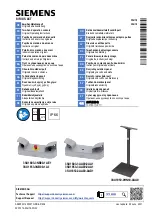
TTM 57SL
FOR
SERATO SCRATCH LIVE •
OPERATOR’S MANUAL
2.1
41
footSWItch
The last soft control is the optional footswitch.
A footswitch allows hands-free control of these
effects parameters:
• Tap to set the BPM.
• Turn the Effect on & off.
• Select between the two Effects Processors
(same as the DECK switch).
The footswitch can also assist with looping and
recording functions. These are shown in the
Groups section.
SEE “FOOTSWITCH DIAGRAM”
ON PAGE 54.
effectS cueIng
You can cue an effect before you turn it on so
that you can check how it sounds before you
bring it into the mix. Button
B5
turns the Effect
Cue on or off. Note that if you turn Effect Cue
on, it stays on even when you switch between
effects.
For an Effect Cue to be heard in the
headphones, the Effect Processor must be
selected, Effect Cue must be on and the Cue
Pan and Master Cue controls must be in the
correct position.
For instance, with a track playing in PGM 1:
1.
Select Processor 1 to choose your Effect.
2.
Select
B1
to route PGM 1 to the Effect.
3.
Select
B5
to Cue the Effect in your phones.
4.
Select
B6
to send the Effect to the Master.
5.
Echo Effects are post-fader, so the fader
needs to be up to send the Effect a signal. Other
Effects do not rely on the fader.
The Effects Cue for an Effect inserted in Main
or Aux Bus is only heard in the headphones if
the Master Cue switch is on. The Hold Echos
are the only Effects that cannot be heard in the
headphones unless it is on and also sent to the
Master.
PGM 1 CUE
PGM 2 CUE
MAIN MIX CUE
CUE
PGM 1 EFFECT CUE
PGM 2 EFFECT CUE
MAIN MIX EFFECT CUE
AUX BUS EFFECT CUE
MASTER CUE
CUE PAN
ON
OFF
Effects Cue Logic Diagram
CONTROL ASSIGNMENT SUMMARY
FILTER EFFECTS
P1
controls the design frequency.
P1
second function taps the BPM, a single tap
re-syncs the tag BPM.
P2
controls the filter resonance.
P2
second function controls the sweep depth.
echo effectS
P1
controls the delay amount.
P1
second function taps the BPM manually, a
single tap re-syncs the tag BPM.
P2
controls the feedback.
P2
second function (no effect in echo effects,
filter cutoff frequency in HP echo effects).
phaSer
P1
controls the design frequency.
P1
second function taps the BPM, a single tap
re-syncs BPM, BPM affects LFO sweep rate.
P2
controls the feedback.
P2
second function controls the phaser depth.
FLANGER
P1
controls the base delay in ms.
P1
second function taps the BPM, BPM affects
LFO sweep rate.
P2
controls feedback, providing fullness to the
flanger effect.
P2
second function controls the depth which
represents the peak delay change.
deSecrator
P1
controls the drive.
P2
controls the down sampler.
P2
second function controls the bit depth.
BASIC EFFECTS CONTROLS
The selected effect is edited with the remaining
soft controls. The function of some controls
depends on the selected Effect. Specific control
functions are detailed for each Effect. The basic
operation of these controls is outlined here:
B5
Toggles the Effects Cue On / Off. This is a
global setting and does not change state when
toggling between Effects Processors. See the
Effects Cueing section to the right for details.
B6
toggles the selected Effects Processor On /
Off.
J1
and
J2
joysticks may operate as transform
switches or be used to control effects
parameters.
J1
and
J2
each feature an eight-
position joystick, a push switch and a green
mode indicator light.
• If the indicator light is off, the associated
joystick operates as a transform switch.
•
If the green indicator light is on, the joystick
is assigned to an effect parameter as shown
on the following pages. Pressing the joystick
toggles between the two modes of operation.
If a second function is not available, pressing
the joystick has no effect.
SEE “CONTROLLING
SCRATCH LIVE FROM THE TTM 57SL” ON PAGE 37.
P1
and
P2
may be used to control Effect
parameters, each consisting of a rotary encoder,
a push switch and a green mode light.
B5
B6
J2
ON
ON
CUE
EFFECT
TRANSFORM
















































